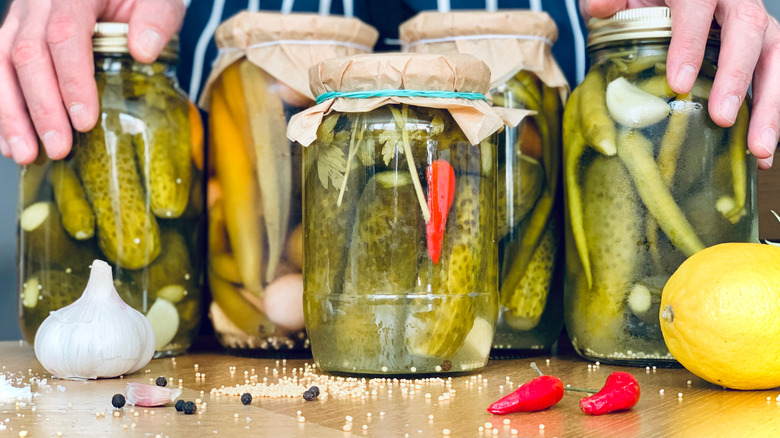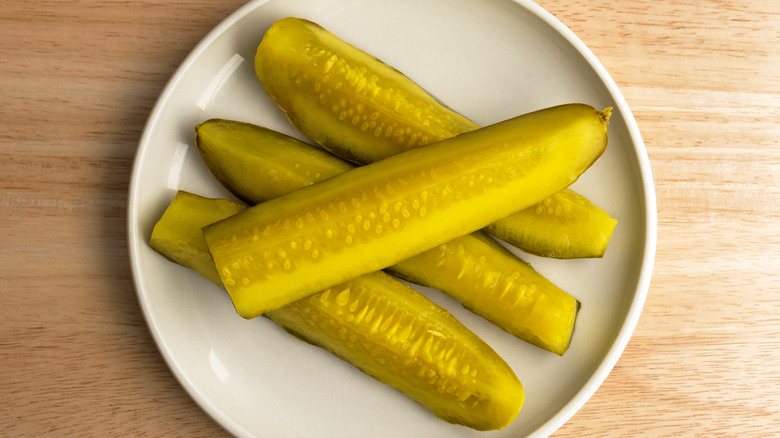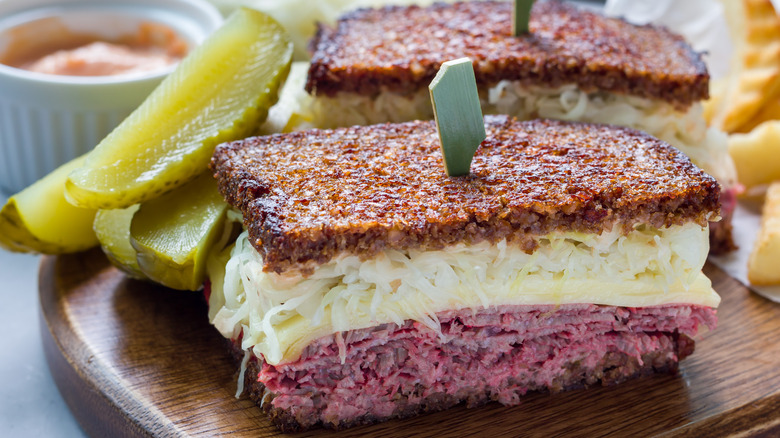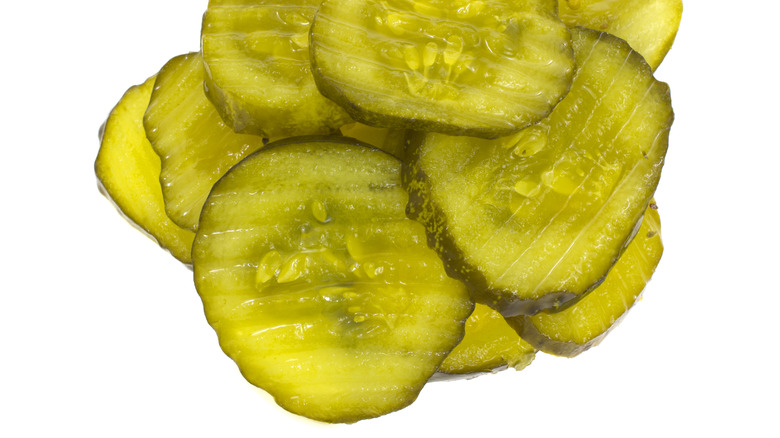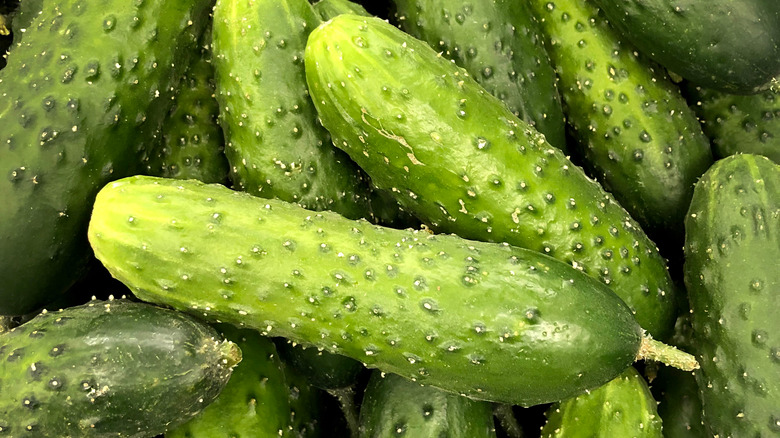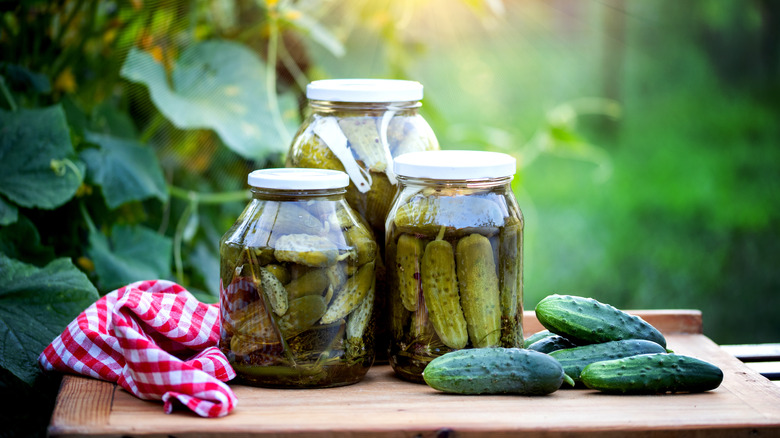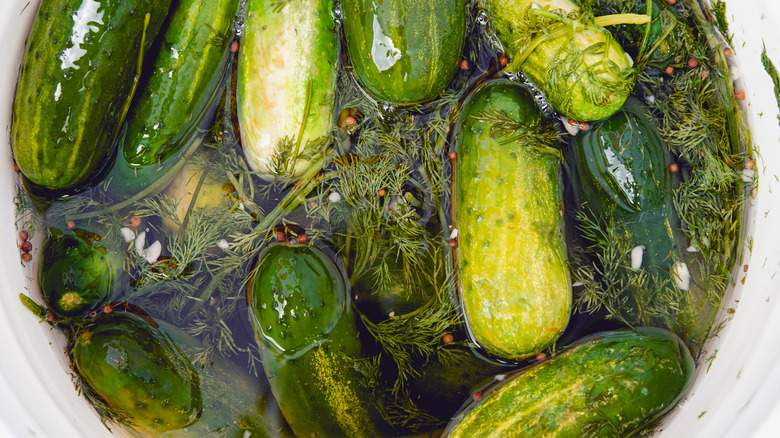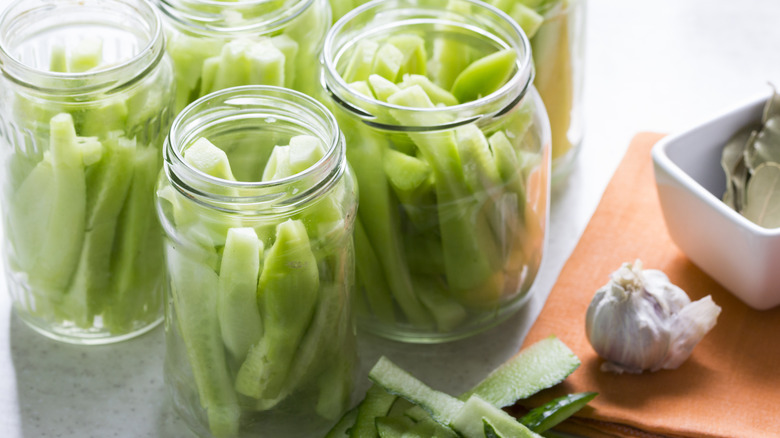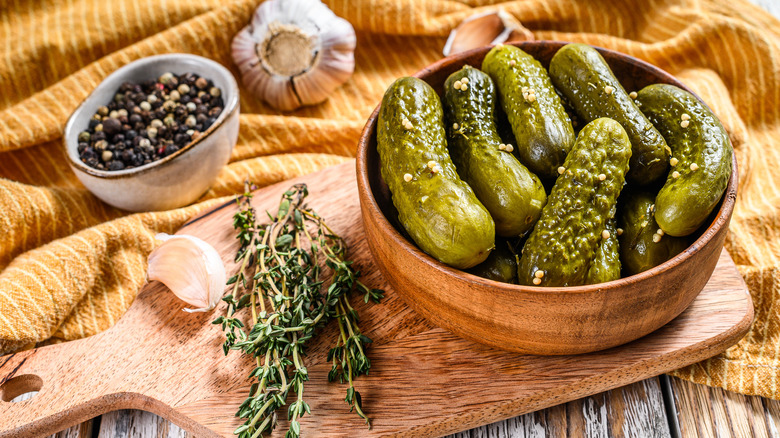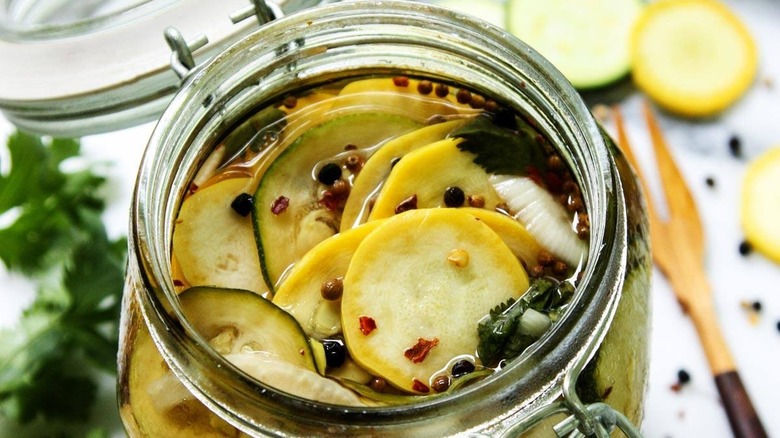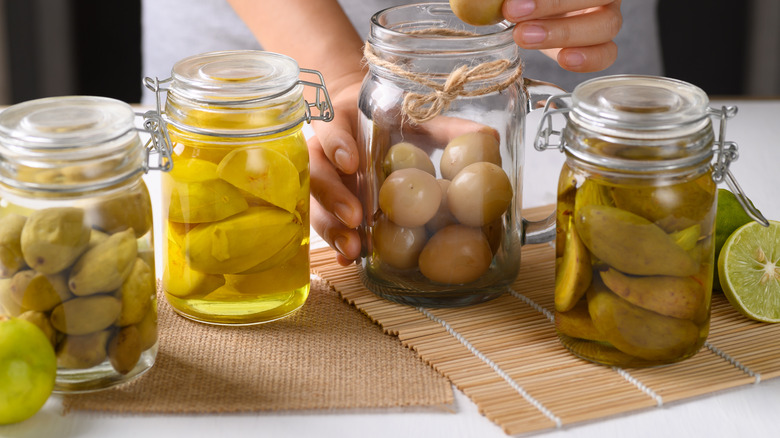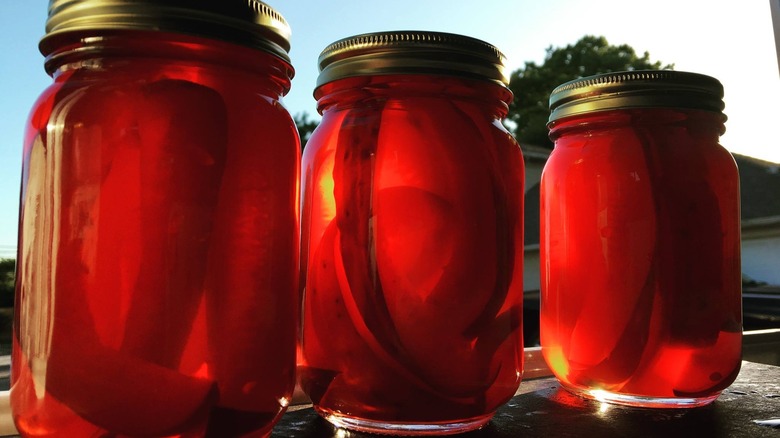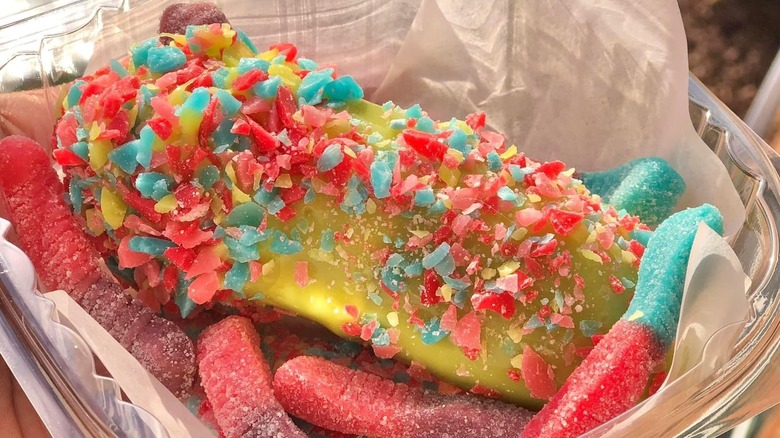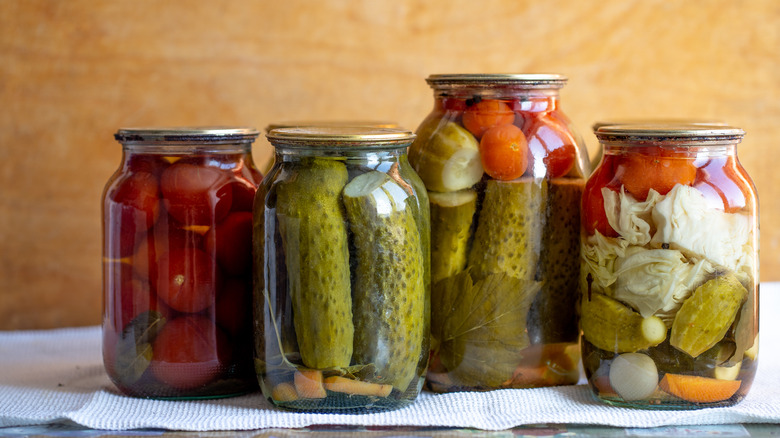15 Different Types Of Pickles And What Makes Them Unique
If you're a pickle-lover, you're probably reading this article already knowing your favorite type of pickle. You're also probably the "can I have your pickle?" person in your friend group. And you don't go to the store just to get pickles — you go to the store in a singular pursuit of your favorite brand's bread and butter spears.
According to PBS, pickles have been around for a long, long time — as far back as 2030 B.C. As a method of preserving food, pickling foods is an extremely important culinary technique. Although there are various types of vegetable pickles worldwide, in America, pickles are dominated by cucumbers, either marinated in a briny liquid or fermented. There are different pickle shapes: chips, spears, wedges, slices, halves, and wholes, all with their respective textures and culinary purposes. While texture is certainly a crucial aspect of pickle enjoyment, so is taste.
The following list of pickles is all made in slightly different ways, whether with various spices, vinegars, or cucumbers. Whether you're eating your pickles whole, throwing them on a burger, or chopping them up for recipes, it matters which kind you use, so read on to potentially discover your new favorite pickle!
1. Dill pickles
The genuine dill pickle is the starlet of all pickles — everyone knows her even if they don't like her. Are dill pickles the original pickle? No, but they're likely the most popular pickles around. When you think of a pickle taste, their typically the salty and tart taste of a dill pickle that comes to mind. According to Allrecipes, jarred, pantry-safe dill pickles are likely made in vinegar-based brine, while the refrigerated versions are made with salt-based brine.
Tasting Table's dill pickle recipe calls for Kirby cucumbers, which are often referred to as "pickling cucumbers" due to their firm, sturdy crunch and mild flavor (via The Spruce Eats). To follow Tasting Table's recipe for dill pickles, submerge quartered Kirby cucumbers in a mixture of water, dill, dill seeds, distilled white vinegar, sugar, kosher salt, coriander seeds, and garlic. If you prefer your pickles whole, plan to let them ferment in the mixture for a few extra days.
2. Kosher pickles
It's common to get dill pickles and kosher dill pickles confused. These are two different types of pickles with distinct ingredients and tastes. First of all, what does kosher mean? Kosher refers to a set of Jewish dietary restrictions. However, according to Chabad, kosher pickles aren't necessarily always "kosher" in the sense that they follow the Jewish dietary guidelines.
When it comes to pickling, kosher-friendly salt is coarser and flaky, making the dishes prepared with it less salty-tasting than those made with denser, grainier salt (via Bon Appétit). The biggest difference between dill and kosher dill pickles is not the inclusion of salt but garlic (via The Cookful). The New York Times' kosher pickle recipe calls for five whole cloves of garlic. Since kosher pickles are more garlicky than dill, they taste great on various sandwiches, and when chopped up, they make for a delicious inclusion in tuna salad!
3. Bread and butter pickles
Another world-favorite pickle is the bread and butter pickle. We mostly see these in the form of pickle chips stacked on sandwiches and burgers. As a pickle, bread and butter pickles have a sweeter flavor when compared to dills. Spoon University cites that this distinctive sweetness is due to the inclusion of sweet onions in the recipe for the pickle marinade along with white vinegar, sugar, salt, mustard seeds, coriander seeds, and celery seeds.
However, it's common for many commercial pickle brands to use high-fructose corn syrup to sweeten the pickles. For example, major pickle distributor Mt. Olive makes their signature bread and butter pickle chips sweet with high-fructose corn syrup. Bread and butter pickles are so popular that Mt. Olive even makes a sugar-free version of them, sweetened by the inclusion of Splenda. Bread and butter pickle chips are a staple for your classic cheeseburger recipe, or you can serve bread and butter spears as a side dish to offset a super salty meal.
4. Gherkins
The first thing one notices about gherkins is their appearance — they are much smaller than most cucumbers, sizing up at about 1 to 2 inches long with a curved and bumpy shape (via MasterClass). Generally, gherkins are pickled with a sweet flavor, although they can also be pickled like standard dill or sour pickles. The texture is the main appeal of gherkins over other larger pickles. Since gherkins are small and have a bumpy surface, they've got a lot more crunch than larger, fleshier cucumbers and pickles.
Gherkins are typically pickled whole rather than sliced into spears, halves, or chips (via The Kitchen Community). For this reason, they aren't usually the kind of pickles that you eat on a sandwich or a burger. It's typical to see gherkins on a charcuterie board or as a side garnish at a deli. Of course, they also make a tasty snack all on their own.
5. Cornichons
It's common for people to mistake cornichons and gherkins as interchangeable terms because of their similar appearance, but we'll set the record straight. Delish cites that cornichons are a bit smaller in size than gherkins, and calls the crunchy pickles "tasty little blighters." According to MasterClass, cornichons are considered "French gherkins." Like other pickles, they can be fermented or marinated in a mixture of herbs like dill, tarragon, or pepper.
Cornichon pickles are made with a small-growing variety of gherkins with pronounced tart and salty flavors (via The Spruce Eats). Like gherkins, cornichons are commonly found on cheese plates or charcuterie boards, as they add a bit of a palate-cleansing, refreshing bite between creamy cheeses, sweet fruits, and salty meats. Tasting Table's cornichon recipe focuses on the French aspect of the pickle and incorporates spices like mustard seeds, black pepper, and herbes de Provence for authenticity.
6. Full-sour pickles
When we think of the flavor of any pickle, two words usually come to mind: salty and sour. However, certain pickles are made to be predominantly sour. These can be broken down into two types of pickles: full-sour and half-sour. If you're guessing that full-sour pickles pack more tang per bite than half-sours do, you'd be correct.
As is implied by their names, full-sour pickles are more tart than half-sour pickles. They achieve more of a sharp flavor than half-sour pickles because they are fermented in a salt-based, non-vinegar solution for about 12 to 16 weeks (via AllRecipes). Sour pickles make great snacks for those who love a tangy bite, but the juice of full-sour pickles can also work well in drinks like pickleback shots. Compared to milder-tasting pickles like dill, the flavor of full-sour pickle juice will provide a more potent recipe for your next pickleback shot.
7. Half-sour pickles
While half-sour pickles are obviously less sour than full-sour pickles, they are still plenty sour. Half-sour pickles are usually fermented for around six to eight weeks (via AllRecipes). As such, Brad Leone of Bon Appétit cites that half-sour pickles tend to pack more of that crisp, satisfying crunch that many people desire from a pickle. Since full-sour pickles soak for double the length of time that half-sours do, they can be a bit soggy and more sour in comparison.
To make his half-sour pickles, Leone uses crisp Kirby cucumbers. He then creates a saltwater mixture of 3.5% salinity, including fresh garlic, celery seed, dill seed, fennel pollen, dill pollen, fresh dill, mustard seed, black pepper, and cherry peppers (an optional ingredient according to Leone). For a simpler half-sour recipe, Brooklyn Farm Girl makes theirs with garlic cloves, bay leaves, coriander seeds, mustard seeds, black peppercorns, and dill.
8. German pickles
There are a handful of foods that come to mind when we think of German cuisine, like sauerkraut, bratwurst, schnitzel, and mustard. Accordingly, German pickles are called senfgurken, which translates to "mustard pickle" in English (via All Tastes German). Aside from their unique ingredients, what makes German pickles different from common American ones like dill pickles is that, rather than being fermented whole, the cucumber skin is peeled before it's pickled (via The Spruce Eats).
You may be thinking that without the skin of the cucumber, these pickles might be kind of soggy. If left too long in the brine, German pickles might lose their crunch, but removing the cucumber peel allows the brine to saturate the cucumbers more quickly than with other pickles. Therefore, there's no need to worry: your German pickles will still have a satisfying crunch to them. Taste-wise, German pickles are slightly sweet and sour. The Spruce Eats shares a German pickle recipe that includes two distinct ingredients: juniper berries and allspice berries. In addition to sugar, these two ingredients give German pickles a uniquely herbaceous and sweet taste.
9. Hungarian pickles
When it comes to ingredients, Hungarian pickles are not terribly different from dill pickles or other common pickles. What makes most Hungarian-style pickles unique is that one of the most important steps in making them is to give them ample sun exposure to help them ferment. Hence, they are often called Hungarian sun pickles or Hungarian summer pickles (via The Spruce Eats).
Many Hungarian pickles are also made by including bread in the fermentation process. According to blogger Cristina the Cooking Pilot, "the bread creates a barrier from the outside air, adds complex sugars for the ferment, and gives it a unique taste." Although including bread isn't always necessary. The Spruce Eats' recipe for Hungarian summer dill pickles has kosher salt, white vinegar, fresh dill, and water.
Hungarian pickles can also be made with various household herbs and spices, such as garlic and peppercorns. For example, blogger Kibitz Spot makes their recipe inspired by pickles she ate in Hungary, which call for fresh dill, garlic cloves, black peppercorns, and juniper berries.
10. Hot pickles
Are you the kind of person who simply thinks that everything tastes better spicy? The kind of person who just douses everything they eat in hot sauce? We've got a pickle you're going to love!
If you'd like to make your own hot pickles, there are tons of ways to do so. You can take any regular pickle recipe and add spicy ingredients like cherry peppers, jalapeños, or habanero peppers. A great example is this drool-worthy recipe from FoodieCrush. This spicy pickle features a dynamic blend of apple cider vinegar, white vinegar, pickling salt, dried dill weed, Thai red peppers (or hot pepper of your choice), garlic cloves, and a mixture of pickling spices. Try it out and feel the heat!
Besides homemade recipes, many major pickle brands also make hot pickles. Mt. Olive, one of the most popular pickle brands in America, sells a buffalo-style kosher dill pickle made with Texas Pete Hot Sauce and a SweetHeat variety of bread and butter chips for those who like things both sweet and spicy (via Mt. Olive Pickles). As you're probably already imagining, spicy pickles can make a mouthwateringly zingy addition to sandwiches and burgers. As a bonus, the pickle juice also adds a flavorful kick to marinades and salad dressings.
11. Lime pickles
Despite their name, lime pickles aren't made with lime juice. Instead, the key ingredient is pickling lime, which is actually calcium hydroxide (via Delighted Cooking). Delighted Cooking cites that pickling lime is used to "preserve the pickles' firmness," meaning lime pickles are typically very crunchy.
A great brand to try is Jake & Amos, who states that the inclusion of pickling lime has origins in the "old days of the Pennsylvania Dutch Country." Pickling lime is a chemical that has been used for many things that don't actually involve pickles — or food — at all, such as whitewash or plaster (via Jake & Amos). Of course, the lime used for pickling is a food-grade version of the chemical used for construction. Still, there are health issues with consuming lime. According to Healthline, studies have linked pickling lime to severe illnesses, so many modern recipes tend to nix the ingredient.
12. Kool-aid pickles
Yup. Kool-Aid pickles exist, and yes, they are made with actual Kool-Aid, the vibrant fruit drinks with the juice pitcher wearing sunglasses as a mascot. When you think of unusual food combinations, fruit punch and pickles are probably one of them, but these pickles are actually quite popular. Historically, it's believed that the Kool-Aid and pickle combo originated in Mississippi, where they cleverly call them "koolickles" (via Taste of Home).
According to Taste of Home, Kool-Aid pickles are made with pickles that are already, well, pickled. That said, Kool-Aid pickles aren't just cucumbers marinated in Kool-Aid. The Taste of Home recipe instructions features draining a jar of whole dill pickles and placing the pickles in a bowl with sugar and an unsweetened Kool-Aid packet of your choice. If you allow the pickles to marinate for about a week, they'll end up with a fun, vibrant color. As you might imagine, Kool-Aid pickles taste fairly sweet and tangy, so they make for great snacks on their own.
13. Cinnamon pickles
We've got another unusual food combo for you: cinnamon and pickles. Weirder than Kool-Aid and pickles? Maybe. However, the end result is similar: pickles that taste sweet. Cinnamon pickles get their name from one of their major ingredients: cinnamon red hot candies. You may think that this makes the pickles spicy, but due to the inclusion of sugar, these pickles end up with a cinnamon flavor and an overall sweet taste.
Similar to German pickles, these pickles call for completely peeled cucumbers. To make them, you'll need to create a mixture of cinnamon red hot candies, cinnamon sticks, pickling lime, sugar, distilled white vinegar, red food coloring, and alum (via AllRecipes). My Farmhouse Table shares a similar recipe and notes that these are commonly called "Christmas pickles." They are eaten on their own or can be included in crudité platters or relish trays. These pickles are not easily found in stores, so you will likely have to make them yourself if you'd like to try them. According to AllRecipes and My Farmhouse Table, making these pickles is a process that takes around four days, but we think they'll be worth it!
14. Candied pickles
By now, we're used to the whole excessively sweet pickles thing. So, candied pickles shouldn't come as too much of a surprise. If there's a market for candied jalapeños, a market for candied pickles doesn't seem too hard to conceive. When we say "candied," we use the term loosely, as it can mean different things to different people. Most candied pickle recipes are simply recipes for sweet pickles.
For example, many candied pickle recipes can resemble this fun candied dill pickle recipe from Food.com. It calls for a drained jar of dill pickles and a mixture of cider vinegar, sugar, and pickling spices. Simple enough! However, there are also candied pickle recipes that are far more extravagant and colorful. YouTuber Apple Boss makes their candied pickles with actual candy — we're talking pickles wrapped in Fruit Roll-Ups. Candied pickles are an example of the boundless creativity that pickle-lovers have when it comes to innovative recipes.
15. Refrigerator pickles
Have you ever realized that when you go to a grocery store, some pickles are sold on shelves with other pantry foods while others are sold in the refrigerated section? This is because pickles that are unpasteurized typically require refrigeration, as refrigerating them slows down the fermentation process so that they don't sour too quickly (via Sweet Home Digest).
While you can buy refrigerated pickles at the store, it is popular to make refrigerator pickles at home, usually for that time of the year when your garden is simply overflowing with fresh cucumbers. However, you can always use store-bought cucumbers to make your own refrigerator pickles. Since they are fairly easy to make, you can get experimental with ingredients. Taste of Home makes theirs with sliced onions, sugar, salt, cider vinegar, mustard seed, celery seed, and cloves. These pickles make for an ideal at-home snack, especially since they are super low in calories and nutrient-rich, with various vitamins and minerals and numerous digestive health properties (via WebMD).
